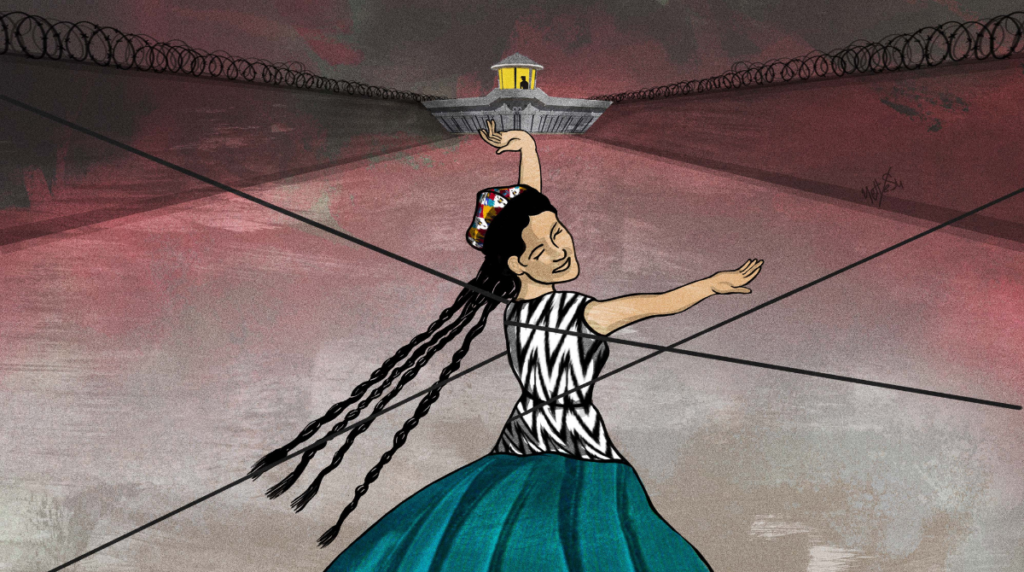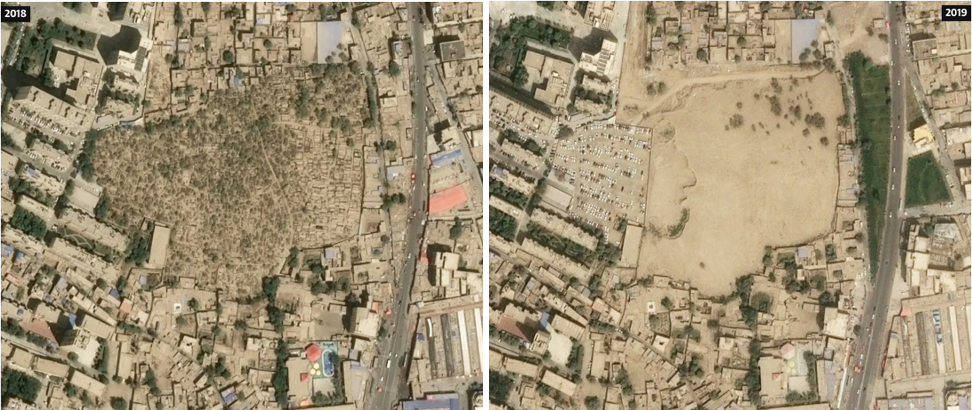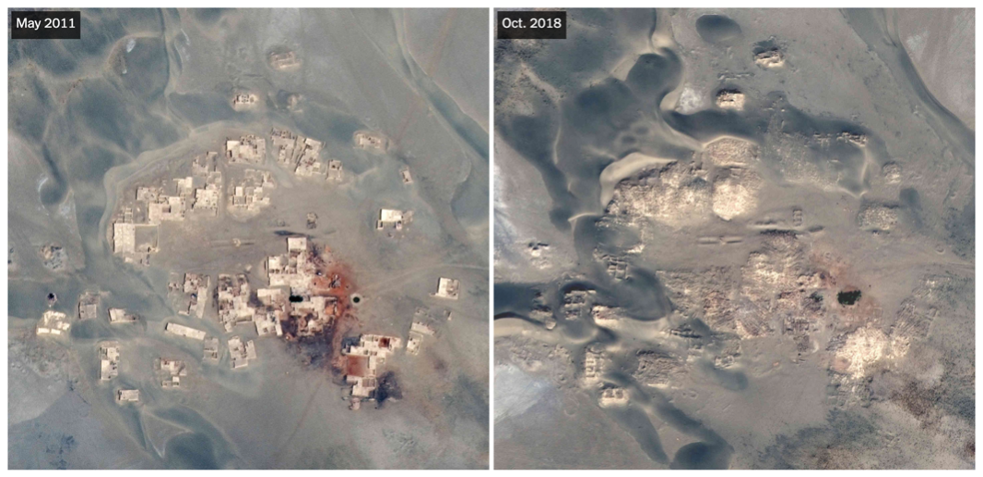Submission for Consideration by the U.S. Department of State Cultural Property Advisory Committee

May 26, 2023
Submission for consideration by the U.S. Department of State Cultural Property Advisory Committee, Uyghur Human Rights Project (UHRP)
The Uyghur Human Rights Project (UHRP) is making the following submission for consideration by the U.S. Department of State’s Cultural Property Advisory Committee in relation to the 2023 Request for Renewal of the 2019 Memorandum of Understanding Between the United States of America and the People’s Republic of China.1U.S. Department of State (January 2019). “Memorandum of Understanding Between the United States of America and China,” online: https://www.state.gov/wp-content/uploads/2019/02/19-114.1-China-Cultural-Exchg-Prop-Impt-Restr.pdf
This submission provides evidence of widespread destruction and marginalization of Uyghur, Kazakh, and Kyrgyz tangible and intangible cultural heritage by the Chinese government. Based on this information, the extension of an agreement on the 2019 Memorandum of Understanding (MOU) would affirm that the Chinese government is protecting its cultural heritage despite clear evidence to the contrary. China has not fulfilled the criteria under U.S. law governing such MOUs, which requires that the State Party involved must have “taken measures consistent with the [UNESCO] Convention to protect its cultural patrimony.”2Convention on Cultural Property Implementation Act. (1983). Pub. L. No. 97-446, 96 Stat. 2329, online: https://eca.state.gov/files/bureau/97-446.pdf
Summary
The government of China is perpetrating crimes against humanity and genocide in the Xinjiang Uyghur Autonomous Region (“Uyghur region”), targeting Uyghur and other Turkic and Muslim-majority peoples on the basis of religion and ethnicity.3The UN High Commissioner for Human Rights, in a report on the human rights concerns in the Uyghur region, stated that “The extent of arbitrary and discriminatory detention of members of Uyghur and other predominantly Muslim groups, pursuant to law and policy, in context of restrictions and deprivation more generally of fundamental rights enjoyed individually and collectively, may constitute international crimes, in particular crimes against humanity.” See “OHCHR Assessment of human rights concerns in the Xinjiang Uyghur Autonomous Region, People’s Republic of China,” available online: https://www.ohchr.org/sites/default/files/documents/countries/2022-08-31/22-08-31-final-assesment.pdf The Chinese government is engaging in a systematic campaign to eradicate Uyghur culture, religion, and language through policy and practice, including the destruction of sacred cultural and religious sites such as mosques, cemeteries, and shrines, as well as marginalizing UNESCO-sanctioned intangible cultural heritage. The government has banned the use of Uyghur language in schools and detained and sentenced scholars wishing to establish Uyghur-language schools within the region.
China’s actions in the Uyghur region constitute what UNESCO calls “strategic cultural cleansing”: the deliberate targeting of individuals and groups on the basis of their cultural, ethnic or religious affiliation, combined with the intentional and systematic destruction of their cultural heritage.4UNESCO, “Reinforcement of UNESCO’s Action for the Protection of Culture and the Promotion of Pluralism in the event of Armed Conflict,” Document 39 C/57, October 24, 2017. As acknowledged in the 2021 International Criminal Court framework on cultural heritage, acts of dispossession and destruction of cultural heritage are often inseparable from—or the precursor to—acts of genocide.5ICC Policy on Cultural Heritage, 2021, p.30, https://www.icc-cpi.int/sites/default/files/itemsDocuments/20210614-otp-policy-cultural-heritage-eng.pdf
Destruction and marginalization of UNESCO-listed heritage
According to UHRP research, the Chinese government’s management of the cultural heritage of the Uyghur region places control firmly in the hands of the government and its chosen commercial partners.6Uyghur Human Rights Project (February 2023). “The Complicity of Heritage: Cultural Heritage and Genocide in the Uyghur Region.” Available online: https://uhrp.org/the-complicity-of-heritage-cultural-heritage-and-genocide-in-the-Uyghur-region Heritage is exploited for economic profit and used to promote the government’s chosen versions of history and culture, regardless of established historical fact and regardless of the rights of communities and culture bearers acknowledged in UNESCO’s conventions. This mismanagement of heritage includes bans on grassroots cultural practices; the detention and imprisonment of culture bearers; forced expulsion of residents from their ancestral lands; and environmental damage to heritage sites.
Demolition and desecration of Uyghur mosques
Evidence clearly indicates that the Chinese government has destroyed Uyghur cultural landmarks, including mosques, shrines, and cemeteries (See figures 1 and 2). In 2019, UHRP conducted an investigation through geospatial analysis, calculating that 10–15,000 Uyghur religious sites have been destroyed or damaged by the Chinese government since 2016.7Uyghur Human Rights Project (October 2019). “Demolishing Faith: The Destruction and Desecration of Uyghur Mosques and Shrines.” Available at: https://docs.uhrp.org/pdf/UHRP_report_Demolishing_Faith.pdf A separate study focused on damage to Uyghur mosques calculated that over 8,500 mosques across the Uyghur region have been demolished by the Chinese government since 2017—a figure representing the destruction of over one third of the region’s total mosques.8Deng, Chao (September 2020). “China Razed Thousands of Xinjiang Mosques in Assimilation Push, Report Says,” The Wall Street Journal. Available at: https://www.wsj.com/articles/china-razed-thousands-of-xinjiang-mosques-in-assimilation-push-report-says-11601049531
Mosques have been forced to remove Islamic architecture, symbols, or Arabic writing, including the crescent moon or domes which adorn the top of the structures.9Buckley, Chris (September 2020). “China Is Erasing Mosques and Precious Shrines in Xinjiang,” The New York Times. Available at: https://www.nytimes.com/interactive/2020/09/25/world/asia/xinjiang-china-religious-site.html Some mosques have also been converted entirely into shops, housing, and even bars.10Nathan Ruser, James Leibold, Kelsey Munro & Tilla Hoja (September 2020). “Cultural erasure: Tracing the destruction of Uyghur and Islamic spaces in Xinjiang,” Australian Strategic Policy Institute. Available at: https://www.aspi.org.au/report/cultural-erasure In one instance, the local government razed a mosque in Atush in order to install a public toilet.11Radio Free Asia (August 2020). “Public Toilet Erected on Former Site of Razed Xinjiang Village Mosque.” Available at: https://www.rfa.org/english/news/uyghur/toilet-08132020142800.html
Destruction of Kashgar Old Town
Nearly 85 percent of the Old City of Kashgar, a 2000-year-old city, was demolished between 2009 and 2017, displacing hundreds of thousands of residents without consultation.12Uyghur Human Rights Project (March 2012). “Living on the margins: The Chinese state’s demolition of Uyghur communities.” Retrieved from: http://docs.uyghuramerican.org/3-30-Living-on-the-Margins.pdf The demolitions resulted in the loss of physical structures including homes, shops and religious sites, as well as patterns of traditional Uyghur life. Most conspicuously, Old Kashgar was not included on a list of Silk Road sites that Beijing recently submitted to UNESCO for World Heritage Status, though it is still a top tourist draw in the region.13Tharoor, Ishaan (July 29, 2009). “Tearing Down Old Kashgar: Another Blow to the Uighurs.” Retrieved from: http://content.time.com/time/world/article/0,8599,1913166,00.html A UNESCO cultural specialist in Beijing called the redevelopment of Kashgar “one of the black spots of heritage conservation.”14Levin, Dan (March 5, 2014). “China Remodels an Ancient Silk Road City, and an Ethnic Rift Widens,” The New York Times. Retrieved from: https://www.nytimes.com/2014/03/06/world/asia/china-remodels-an-ancient-silk-road-city-and-an-ethnic-rift-widens.html
Harassment, detention and imprisonment of Uyghur and Turkic cultural figures
Since April 2017, the Chinese government has interned, imprisoned, or disappeared at least 312 Uyghur and other Turkic Muslim intellectual and cultural elites.15Uyghur Human Rights Project (December 2021). “The Disappearance of Uyghur Intellectual and Cultural Elites: A New Form of Eliticide,” Retrieved from: https://uhrp.org/report/the-disappearance-of-uyghur-intellectual-and-cultural-elites-a-new-form-of-eliticide/ These actions amount to a campaign to suppress Uyghur cultural expression.16Uyghur Human Rights Project (March 25, 2019). “Detained and Disappeared: Intellectuals Under Assault in the Uyghur Homeland.” Available at: https://uhrp.org/press-release/detained-and-disappeared-intellectuals-under-assault-uyghur-homeland.html Among those detained include Uyghur teachers, scholars, students, poets, musicians, as well as the academic staff of Xinjiang University.17Uyghur Human Rights Project, “Report: The Persecution of the Intellectuals in the Uyghur Region Continues,” January 2019. Available at: https://docs.uhrp.org/pdf/UHRP_UPDATE-ThePersecution_ofTheIntellectuals-in-the-Uyghur-Region.pdf Those targeted include writers, poets, academics, researchers, artists, and performers.18A full list can be found here: https://uhrp.org/intellectuals/ As a component of genocide, the assault on intellectual and cultural elites may constitute a new form of eliticide meant to exterminate Uyghur (and other) cultural identity.
Restrictions on religious practice and mother language teaching
The teaching of religion is also prohibited from curriculum at all education levels in the Uyghur region. Outside of schools, Uyghurs under the age of 18 are unable to enter mosques or participate in religious activities of any kind.19Hoja, G. (February 6, 2006), “China Bans Officials, State Employees, Children from Mosques,” February 2006. Radio Free Asia Uyghur Service. Available at: https://www.rfa.org/english/uyghur/uyghur_religion-20060206.html In 2018, Uyghur students were forced to sign pledges in schools stating that they would not fast during Ramadan.20Hoja, G. (May 21, 2018), Uyghur schoolchildren, Parents Forced to Abstain From Fasting During Ramadan, Radio Free Asia Uyghur Service. Available at: https://www.rfa.org/english/news/uyghur/schoolchildren-05212018151019.html


